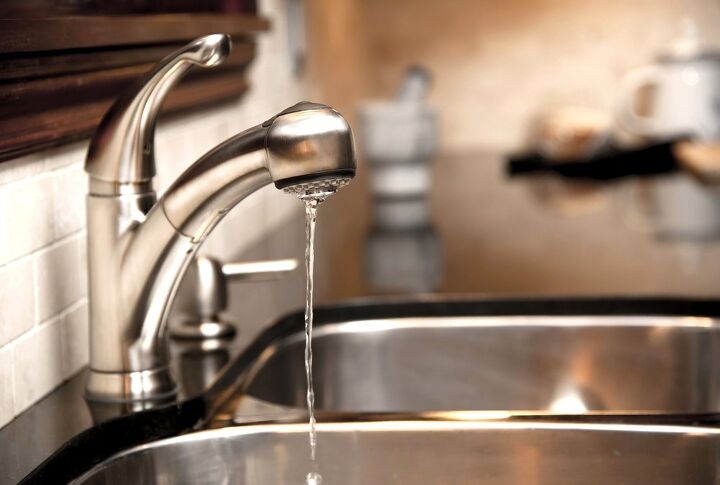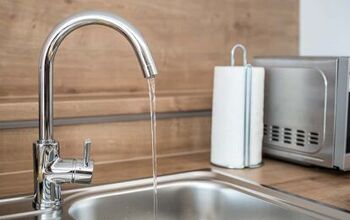What Causes Low Water Pressure At A Kitchen Sink?

The other day, my husband tried to boil up some pasta. He turned on the kitchen sink to fill up the pot, only to notice the water dribbling out. This was not like our faucet! We called over the super, and then he found out that a pipe that fed the faucet water had a leak. One quick patch job later, we were able to get strong water again. But, this isn’t the only cause of low water pressure in your kitchen sink…
The most common reason for low water pressure include:
- Aerator/Cartridge Clogs
- Leaks In The Plumbing
- Repairs
- Pressure Valve Issues
- Closed Shut-Off Valves
Getting low water pressure can be annoying, but it can also be a sign that it’s time to whip out your plumbing gear. Let’s discuss what you can do to get this fixed.
Do You Need to Hire a Plumber?
Get free, zero-commitment quotes from pro contractors near you.

What’s Causing My Kitchen Sink’s Low Water Pressure?
There is a lot to say about having a bad kitchen water flow. It’s aggravating. It could make you worry about your water purity. Oh, and it is usually a quick fix…
1. Repairs
Before you panic, stop and ask yourself if you live in an apartment building or a condo. If you do, then call up the maintenance office to find out what’s going on. More specifically, ask about repairs. In most cases, large buildings that have a sudden drop in water pressure often have it as a side effect of repairs being performed in the building. Wait it out, and you might see an improvement.
Note: If you are a renter, your landlord might be liable for repairing your faucet or water pressure. Call them and ask them to fix the low water pressure.
2. A Clogged Aerator/Faucet Cartridge
The most common reason why your water faucet isn’t pumping out water at a typical pressure deals with kitchen faucet aerators. Most kitchen faucets have an aerator or cartridge that works to help add oxygen to your water. At times, they can also help filter water and direct water flow. Though it’s not supposed to happen, sometimes, these aerators and cartridges get clogged.
When they get clogged, you will have to remove them from the faucet and either clean them out or replace them. With cartridges, you may also be able to tighten them into place. It can help. Once that’s done, you will be able to use your faucet normally.
3. Pressure Reducer Valve Issues
Pressure reducer valves are the part of your plumbing system that helps manage the pressure of your water. This bell-shaped valve is on the outside of your home where the water line meets your home plumbing system. Go outside, then adjust it. If it fixes the problem, great. However, it could also be broken.
If you feel it’s still the pressure reducer valve, check for all other items on this list, then revisit it. You don’t want to have to replace it only to find out that it didn’t need to be replaced.
4. The Water Shutoff Valve
Your water shutoff valve is what you need to shut the water’s flow off to your plumbing system during repairs. Most of the time, it doesn’t really get used. It just sits there, turned off. Unfortunately, this means that hard water buildup can start to grow on the inside of the valve. At times, grime can also start to grow on the outside of your valve.
When your water shutoff valve gets too crusty, it will start to impact your home’s water pressure. Check your water shutoff valve under your sink. If it appears to be crusted over or it doesn’t seem to be able to move well, you need to soak it in vinegar to loosen up the hard water. If you have a reason to believe it’s crusted inside, you may need to remove the valve and clean it.
In some cases, you may also need to replace the shutoff valve. If this happens, you will need to turn off the water to your home to ensure you don’t end up with a mess. We strongly suggest doing this professionally.
5. Leaks In The Rest Of Your Plumbing
If you notice that your aerator is fine and the valves are squeaky clean, then you might have a bigger issue on your hands. Though this is rarely ever the root cause, the truth is that a leak in your plumbing can cause your water flow to turn down to a trickle. These tend to be the most common sources of plumbing leaks that affect kitchen sinks:
- Under Your Sink. This could be a bad link underneath your sink that’s causing water to pool at the bottom of your cabinet. In the majority of cases, the leak can be seen from the opening of the water line that’s feeding your faucet.
- The Top Of Your Sink. Does your faucet base leak? If so, that’s precisely why your water pressure is low. The extra water is leaking out before it can even hit the faucet!
- Around Your Toilet. Believe it or not, many homes will have a direct link from your bathroom to your kitchen and vice versa. The line between the two could be where the leak happens to be.
- Near The Washing Machine. A lot of homes get built with a line from the sink to the washer. If the piping that leads water to your washer is broken, it will lead to low water pressure elsewhere.
When Should You Call A Professional?
If you notice that your water pressure is still low despite everything, then you may have a problem that deals with a hidden pipe burst, a municipal issue, or something that may be a little more difficult to diagnose. Of course, if you do not feel comfortable fixing your own plumbing, calling a professional is definitely something you should consider doing.
Professional plumbers and contractors are able to find leaks that most other people would overlook. For example, they may be able to figure out whether or not a pipe burst behind a wall without having to open the wall. So, if all else fails, ask for some help with your diagnostic.
Do You Need to Hire a Plumber?
Get free, zero-commitment quotes from pro contractors near you.

Related Questions
How can you tell if the city’s water line burst?
In many cases, people can tell when a city’s water line has burst through a phone call or news alert. However, you can usually tell from the way that your water is behaving. When the water main bursts near your home, you won’t be able to get ANY water in any of your fixtures. In fact, your neighbors will also be unable to turn on their taps. If you and your neighbors are having an issue, it’s a municipal break.
What does it mean if your hot water pressure is low, but your cold is fine?
In this case, the issue is not a leak or anything similar to that. Rather, having shoddy warm water pressure means that it’s time to take a look at your water heater. Your hot water heater is where your hot water is going to be stored. If your water isn’t coming out hot or if it’s only a trickle, it could be a problem dealing with your tank’s ability to store water or heat it up to proper temperatures.
What is the normal water pressure reading for a house?
It depends on the house itself, but there is a proper range for water pressure that you should be aware of. Most homes will have a water pressure reading between 30 to 80 PSI. Most people prefer to have their water pressure ratings on the higher end of things, simply because it means you’ll get all the water you need in a shorter amount of time.If your pressure level dips below 30 or if you noticed a dip in pressure, it’s time to call a plumber.

Ossiana Tepfenhart is an expert writer, focusing on interior design and general home tips. Writing is her life, and it's what she does best. Her interests include art and real estate investments.
More by Ossiana Tepfenhart



























